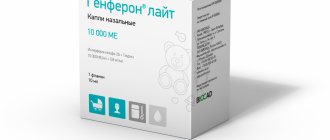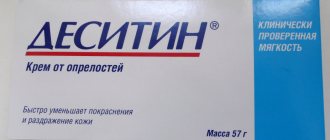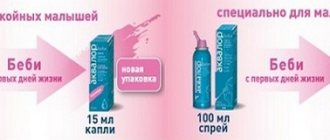Composition per 1 ml
Active substance: xylometazoline hydrochloride – 0.50 mg or 1.00 mg; Excipients: disodium edetate (Trilon B) – 0.50 mg, sodium chloride – 9.00 mg, benzalkonium chloride – 0.15 mg, potassium dihydrogen phosphate – 3.63 mg, sodium hydrogen phosphate dodecahydrate – 7.13 mg, purified water – up to 1 ml.
Description: transparent, colorless or slightly colored liquid.
Pharmacotherapeutic group: anticongestive agent – alpha-adrenergic agonist.
ATX code : R01AA07
Indications for use of Rinostop
The drug is used:
- with nasal congestion and runny nose against the background of acute respiratory disease ;
- for chronic, including allergic rhinitis, accompanied by nasal congestion in short courses;
- for acute and chronic sinusitis ( sinusitis , sinusitis ), accompanied by nasal congestion in short courses;
- for acute and chronic otitis media to relieve swelling of the auditory tube connecting the middle ear to the nasopharynx;
- when conducting diagnostic studies (for example, rhinoscopy ) of ENT organs.
Contraindications
Hypersensitivity to xylometazoline and other components of the drug, arterial hypertension, tachycardia, severe atherosclerosis, glaucoma, atrophic rhinitis, surgical interventions on the meninges (in history), conditions after transsphenoidal hypophysectomy, children's age (up to 2 years - for 0.05% spray , up to 6 years for 0.1% spray), pregnancy. Do not use during therapy with monoamine oxidase inhibitors and tricyclic antidepressants (including the period of 14 days after their discontinuation).
Carefully
In patients taking monoamine oxidase inhibitors (MAO) and other drugs that increase blood pressure (including for up to 14 days after their discontinuation); in patients with concomitant severe forms of cardiovascular diseases (arterial hypertension, coronary heart disease, chronic heart failure, tachycardia, arrhythmias); with hyperthyroidism, diabetes mellitus, pheochromocytoma, prostatic hyperplasia with clinical manifestations (urinary retention), severe atherosclerosis, porphyria, during pregnancy and during
breastfeeding, with increased intraocular pressure, chronic renal failure, in patients taking tricyclic antidepressants and bromocriptine, as well as other drugs that increase blood pressure. If you have one or more of the diseases and conditions listed above, you should consult your doctor before starting to take the drug.
Directions for use and doses
Intranasally.
Spraying is carried out after removing the safety cap from the sprayer. The sprayer is inserted into the nose and, pressing on its base, sprays for 1 second.
For adults and children over 6 years of age (0.1% spray): one spray from a spray bottle into each nasal passage, usually 3-4 sprays per day are sufficient; should not be used more than 3 times a day.
For children aged 2 to 6 years (0.05% spray) one spray from a spray bottle into each nasal passage 1 or 2 times a day; should not be used more than 3 times a day.
Do not use the drug without a break for more than 3-5 days.
Rhinostop
STUFFY NOSE?! RINOSTOP® SPRAY – ACTIVE IN A FEW MINUTES1, COSTS INEXPENSIVE!
for adults and children from 2 years old
Advantages of the drug
- has a local vasoconstrictor effect
- due to narrowing of the blood vessels of the nasal mucosa:
- helps eliminate swelling and hyperemia (redness) of the mucous membrane
- helps relieve nasal congestion
- helps restore patency of the nasal passages and facilitate nasal breathing
Advantage of the release form
- 2 release forms provide the possibility of using the drug in people of different age groups:
- nasal spray 0.05% – 15 ml: for children from 2 to 6 years old
- nasal spray 0.1% - 15 ml: for adults and children over 6 years old
Indications for use
- acute respiratory diseases with symptoms of rhinitis (runny nose)
- acute allergic rhinitis
- sinusitis,
- eustacheitis
- hay fever
- otitis media (to reduce swelling of the nasopharyngeal mucosa)
- preparing the patient for diagnostic manipulations in the nasal passages
Rinostop is the winner of the “No. 1 Brand in Russia” award in the category of means for treating the common cold in 2021.
Side effect
With frequent and/or prolonged use - irritation and/or dryness of the nasopharyngeal mucosa, burning and paresthesia of the nasal mucosa, sneezing, hypersecretion of the nasal mucosa; swelling of the nasal mucosa, vomiting, headache, palpitations, increased blood pressure, tachycardia, arrhythmia, insomnia, blurred vision, depression (with long-term use of high doses).
Benzalkonium chloride, which is part of the drug, can cause irritation of the nasal mucosa.
Pharmacodynamics and pharmacokinetics
The active substance of Rinostop, xylometazoline, belongs to the group of alpha-adrenergic agonists with local vasoconstrictor effects. Alpha adrenergic agonists are drugs that stimulate alpha adrenergic receptors , located in the walls of blood vessels and reacting to adrenaline , norepinephrine and other substances with a similar effect.
When applied to the mucous membrane of the nasal cavity, the drug causes a narrowing of the blood vessels located in it, but is almost not absorbed into the blood and does not have a general (systemic) effect on the human body. This helps to reduce blood flow in the veins and significantly reduce the perspiration of the liquid part of the blood through the walls of blood vessels. As a result, swelling of the mucous membrane is quickly relieved and nasal breathing is restored. The amount of nasal discharge also decreases. Eliminating swelling in the nasal cavity also improves the condition of the hearing aid.
At the same time, the drug does not have a negative effect on the mucous membrane, including its ciliated epithelium, which cleanses the nasal cavity of foreign particles. Long-term use of drops or spray (more than 5-7 days in a row) can lead to paresis of the smooth muscles of blood vessels and their prolonged dilation, accompanied by persistent swelling and nasal congestion.
The effect of the drug begins a couple of minutes immediately after it has been applied to the mucous membrane of the nasal cavity and can last for several hours.
Overdose
In case of an overdose or accidental ingestion of the drug, the following symptoms may develop: nausea, vomiting, cyanosis, fever, tachycardia, arrhythmia, increased blood pressure, shortness of breath, mental disorders, depression of the central nervous system (drowsiness, decreased body temperature, bradycardia, decreased blood pressure, respiratory arrest and coma).
Treatment: symptomatic: in case of accidental ingestion - gastric lavage, taking activated charcoal.
special instructions
Long-term use and overdose of the drug should be avoided, especially in children. Avoid contact of the drug with the eyes. To avoid the spread of infection, it is necessary to use the drug individually.
Impact on the ability to drive vehicles and machinery . After long-term use of cold remedies containing oxymetazoline, and in doses higher than recommended, a general effect on the cardiovascular system cannot be excluded.
system and the central nervous system. In these cases, it is recommended to be careful when driving vehicles and engaging in other potentially hazardous activities that require increased concentration and speed of psychomotor reactions.
Pharmacological effect
Xylometazoline belongs to alpha-adrenergic agonists - substances that stimulate the activity of specific receptors in the vascular walls that are sensitive to adrenaline and nonadrenaline. The result of its action is a rapid narrowing of the lumen and a decrease in capillary permeability upon contact with mucous membranes. Thanks to this, swelling at the site of inflammation is significantly reduced, the intensity of mucous discharge during rhinitis is reduced, and it becomes possible to breathe normally.
The vasoconstrictor effect of xylometazoline is not accompanied by disturbances in the condition of the mucosa or changes in its functions. The ciliated epithelium, which traps particles of dust and other contaminants penetrating into the nasal cavity, does not reduce activity during the use of Rinostop.
The use of the drug also does not have a systemic effect. Xylometazoline is absorbed into the general bloodstream in small quantities, narrowing only the capillaries of the mucous membrane. Rinostop does not affect the duration of diseases and the intensity of their course. Its task is to eliminate negative symptoms of congestion and restore normal well-being during illness.
The effect of using the solution occurs within 2–5 minutes. after applying it to the mucous membranes: the swelling resolves, the lumen of the nasal passages increases, opening up access to air. The effect of the drug lasts up to 5–7 hours.
What Rinostop contains
The main active component of the drug is xylometazoline hydrochloride. This substance belongs to alpha-adrenergic agonists; when applied topically, it causes a reflex vasoconstriction.
Rinostop is produced in the form of:
- nasal spray: in bottles with a dispenser spray with a capacity of 10–30 ml, with a concentration of 0.1 and 0.05% of the active substance;
- nasal drops: similar volume and concentration in bottles with a drip dispenser.
Among the auxiliary components of the product: distilled water and stabilizing additives.
Interaction with other drugs
When used concomitantly with monoamine oxidase inhibitors (during the previous 2 weeks and within 2 weeks after their discontinuation), tricyclic antidepressants or other drugs that increase blood pressure, an increase in blood pressure may occur. The drug slows down the absorption of local anesthetic drugs and prolongs their effect.
Co-administration of other vasoconstrictor drugs increases the risk of side effects.
Rinostop price
Rinostop price in Moscow:
- Rinostop nasal drops 0.1% and 0.05% 10 ml - 21 - 25 rubles;
- nasal spray 0.1% And 0.05% 15 ml - 56 - 65 rubles.
Rinostop tablets, produced by the pharmaceutical company Bosnalek (Bosnia and Herzegovina) are not synonymous with Rinostop drops and spray, as they have a different composition.
- Online pharmacies in RussiaRussia
ZdravCity
- Rinostop Aqua Norm for runny nose 3+, nasal spray, 100% sea water 125 ml Laboratuar De La Mer
328 rub. order - Rhinostop nasal drops. 0.05% 10ml JSC "LECCO"
29 RUR order
- Rinostop 0.05% 15 mlPharmstandard-Leksredstva OJSC
86 rub. order
- Rhinostop nasal drops. 0.1% 10ml ZAO LEKKO/Pharmstandard
32 RUR order
- Rinostop Aqua Forte for runny nose from 6 months, nasal spray, 100% sea water 125 mlLaboratory De La Mer
RUB 327 order
Side effects of Rinostop
Side effects occur mainly with overdose, long-term (more than 5 days in a row) use, or if there are contraindications for the use of this drug. , dry nose , burning , sneezing most often appear , and sometimes the runny nose worsens.
Less commonly, with long-term use, side effects manifest themselves in the form of a sharp dilation of the blood vessels of the nasal mucosa, which is accompanied by swelling of the mucous membrane, nasal congestion and heavy discharge and disturbances in nasal breathing.
In addition, with prolonged use of drops and spray without interruption, mood changes in the form of depression may occur.
Rinostop's analogs
Level 4 ATX code matches:
Xymelin Eco
Xymelin
Nazivin
Galazolin
Lazorin
Nazivin Sensitive for children
Otrivin
Naphthyzin
Sanorin
Knoxprey
For the nose
Lazolvan Rino
Afrin
Rhinorus
Eucazoline Aqua
Rinazolin
Grippostad Reno
Farmazolin
Xylometazoline
Nazol Advance
Analogues are drugs from different drug groups that are used to treat the same diseases. Analogues of Rinostop - drugs that relieve swelling of the nasal mucosa: naphazoline ( Naphthyzin , Sanorin ), Oxymetazoline ( Nazivin , Nazol , Knox-spray ), phenylephrine ( Nazol Baby ), tetrizoline ( Tetrin ), tramazolin ( Lazolvan Rino ), dimethindene + phenylephrine.



